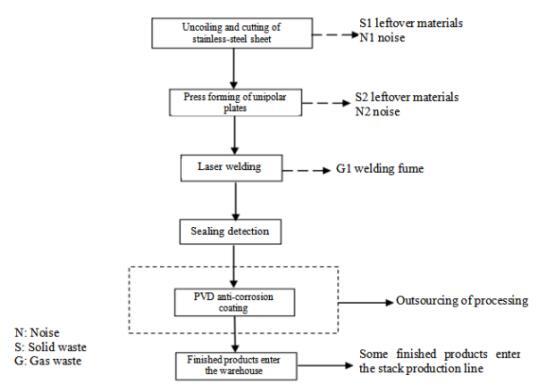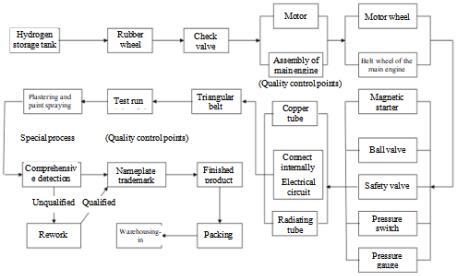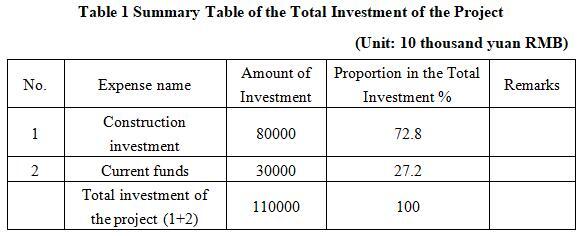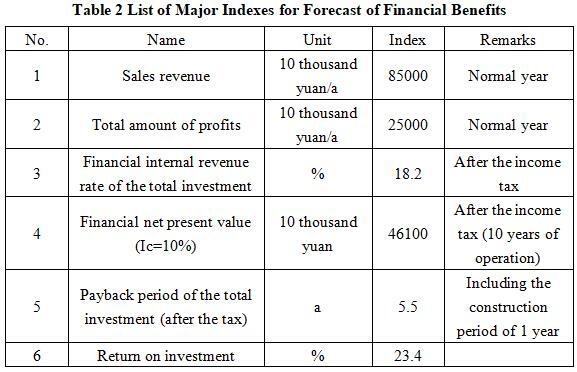Hydrogen Energy
Hydrogen Fuel Cells and Key Components Production Project of Songyuan City
1. Introduction to the Project
1.1 Project background
1.1.1 Product introduction
The hydrogen fuel cells and their key components production project has demonstrated significant feasibility in multiple dimensions such as market demand, geographical location, construction scale, investment planning, economic benefits, and technological strength. The implementation of the project will help promote the development of the clean energy industry, and enhance the regional economic strength and industrial competitiveness.
The key components mainly include hydrogen fuel cell engine, air compressor, humidifier, and metal bipolar plates, etc. These components are the core components of hydrogen fuel cell system, working together to achieve efficient and clean energy conversion.
The advantages of linkage production are mainly reflected in the following aspects: Firstly, it can improve production efficiency, achieve seamless connection between components through optimizing the production process, and shorten the production cycle; Secondly, it can reduce costs of links such as raw material procurement, production processing, and logistics distribution through large-scale production; Thirdly, it can ensure product quality by implementing a strict quality control system to ensure that every component meets the design requirements, thereby improving the reliability and durability of the entire hydrogen fuel cell system.
In addition, linkage production can also promote technological innovation and industrial upgrading. In the production process, the enterprises can continuously optimize their production processes and procedures, introduce advanced production technologies and equipment, and improve production efficiency and product quality. Meanwhile, through close cooperation with upstream and downstream enterprises, a coordinated development of the industrial chain is formed to promote the rapid development of the entire hydrogen fuel cell industry.
1.1.2 Market prospect
(1) Project construction background
In the wave of the Green Revolution, hydrogen energy has become the core driving force for promoting energy transformation due to its abundant resources, its essence as green energy, and its wide application. In response to the urgent global demand for carbon peaking and carbon neutrality, the National Development and Reform Commission and the National Energy Administration have jointly formulated the Medium- and Long-Term Plan for the Development of the Hydrogen Energy Industry (2021-2035), aiming to guide us towards a cleaner, more low-carbon, and more efficient energy future.
Major developed countries around the world have attached great importance to the development of the hydrogen energy industry, and hydrogen energy has become a key strategic choice to accelerate energy structure transformation and cultivate new economic drivers. The key technologies of the global hydrogen energy industrial chain are maturing, the shipment volume of fuel cells is rapidly increasing, the cost is continuously decreasing, the construction of hydrogen energy infrastructure is accelerating significantly, and regional hydrogen energy supply networks are forming gradually.
Hydrogen fuel cell is an equipment that converts hydrogen into electric energy. According to the different electrolytes, hydrogen fuel cells are mainly divided into proton exchange membrane fuel cells, alkaline fuel cells, solid oxide fuel cells, phosphoric acid fuel cells, and molten carbonate fuel cells, etc. In the industrialization process of hydrogen energy, hydrogen fuel cells are one of the key links for the large-scale promotion and use of green hydrogen as a new energy.
Given the above background, national policy guidelines, and the planning and standard requirements of the battery industry, it is currently an excellent opportunity to develop clean, safe, and efficient hydrogen energy.
(2) The necessity of project construction
Responding to the national energy strategy:
At the critical period of energy production and consumption revolution in China, the country has explicitly incorporated hydrogen energy into the national energy system and introduced a series of policy measures to encourage and support the development of the hydrogen energy industry. Important documents such as the 13th Five-year Plan for Energy Development and the Development Plan for the New Energy Vehicle Industry (2021-2035) all emphasized the importance of accelerating the research and industrialization of hydrogen fuel cell technology, and clearly pointed out the need to build a hydrogen energy industrial chain and promote the application of hydrogen energy in transportation, energy storage, and other fields.
The implementation of the hydrogen fuel cells and key components production project in Fuyu City is a positive response to the national energy strategy. This will help grasp the policy window period, enjoy the policy dividends of the country in terms of funding subsidies, tax incentives, infrastructure construction, etc., and quickly promote the scale and commercialization process of the hydrogen energy industry.
Assist in achieving the “dual carbon” goal:
Faced with the challenge of global climate warming, China has pledged to have achieved carbon peaking by 2030 and carbon neutrality by 2060. Hydrogen energy, as a clean energy, produces almost no greenhouse gas emissions during production and use, which is of great significance for reducing the carbon footprint of the whole society and improving the air quality.
The project promotes the localization production of hydrogen fuel cells and key components, reduces reliance on fossil fuels, and effectively lowers carbon emissions in transportation, industrial production, and other fields. Meanwhile, the project adheres to the concept of green production, adopts environment-friendly materials and advanced technologies, ensures energy conservation and emission reduction in the production process, and is highly consistent with the national ecological development concept of “Lucid waters and lush mountains are invaluable assets”, contributing to the achievement of the “dual carbon” goal.
Promoting economic transformation and social progress:
The implementation of the project has a significant positive impact on the socio-economic development of Fuyu City and even wider region. The project will directly promote the local employment, especially the introduction of high-tech talents, optimize the industrial structure, cultivate new economic growth points, and enhance the economic competitiveness. After the successful operation of the project, it will enhance the city’s brand image, attract more investment, and promote opening up and cooperation with the outside world. In addition, the application of hydrogen fuel cell technology will promote convenient transportation and environmental protection, optimize the energy consumption structure, enhance the public awareness of green and low-carbon lifestyles, and form a social trend that advocates environmental protection and pursues sustainable development.
(3) Market prospect of the project
With the strengthening of environmental protection policies and commitments to reducing greenhouse gas emissions, the potential of hydrogen as a clean energy is gradually being recognized. Hydrogen fuel cell, as a clean and efficient energy conversion technology, has shown a broad market prospect. In China, the rapid development of the new energy vehicle industry has gradually made hydrogen fuel cell vehicles the focus of market attention, thereby driving the rapid development of the hydrogen fuel cell components industry and continuously expanding the market size. According to data from 2023, the sales volume of hydrogen fuel cell vehicles in China was approximately 5,800 vehicles.
With the support of national policies for the hydrogen energy industry and the promotion of clean energy transformation, the application of hydrogen fuel cells in fields such as transportation, energy storage, and distributed power generation continues to increase, which directly drives the demand for related components.
In recent years, with the continuous development of hydrogen fuel cell technology and the expansion of its application fields, the market size of hydrogen fuel cell components has also shown a rapid growth trend.
Data showed that: From 2018 to 2024, the overall market size of hydrogen fuel cell components industry in China has shown an upward trend. The market size was 720 million yuan in 2018, and has grown to 5.99 billion yuan by 2024. The current market situation shows a good development trend, although the growth rate fluctuates, it is mostly at a high level in most years.
In such a market environment, hydrogen fuel cell component suppliers are confronted with enormous opportunities and challenges. On the one hand, technological progress and cost reduction have made the commercial application of hydrogen fuel cells more feasible, providing a broad market space for component suppliers. On the other hand, with the intensification of market competition, the component suppliers need to continuously improve the product quality, reduce cost, and accelerate technological innovation to meet the market’s demand for high-performance and high-reliability components.
In addition, with the global emphasis on environmental protection and sustainable development, the application prospect of hydrogen fuel cell technology is also very broad internationally. The International Energy Agency (IEA) predicts that, the global number of hydrogen fuel cell vehicles will have reached over 10 million by 2030. This will bring new growth points to the hydrogen fuel cell components industry, especially in regions such as Europe, North America, and Asia.
To sum up, the hydrogen fuel cell components industry is currently in a rapidly developing stage, with enormous market potential. However, the industry participants need to pay close attention to changes in policy orientation, technological progress, and market demand, so as to grasp the pulse of the industry development and achieve sustainable development.
1.1.3 Technical analysis
(1) Production process flow of metal bipolar plates
As an important component of fuel cell stacks, metal bipolar plates mainly play multiple roles such as supporting MEA (membrane electrode assembly), separating hydrogen and oxygen, collecting electrons, conducting heat, providing hydrogen and oxygen channels, discharging water generated from reaction, and providing coolant channels.

(2) Hydrogen fuel cell engine
The fuel cell engine is the core component of fuel cell vehicles, which is a power generation device that directly converts fuel hydrogen and oxygen in the air into electric energy through electrochemical reactions.

PID diagram of hydrogen fuel cell engine
(3) Air compressor
Hydrogen, as an efficient and clean energy, has a broad application prospect in fields such as automobiles, aviation, and fuel cells. While the hydrogen energy air compressor is a key equipment for mixing, compressing, storing or transporting hydrogen and air.
Process flowchart of hydrogen energy air compression production
1.1.4 Advantageous conditions of project construction
(1) Policy advantages
The project complies with relevant policy requirements such as the National 14th Five-Year Plan and 2035 Development Plan, the Opinions of the Central Committee of the Communist Party of China and the State Council on Fully, Accurately and Comprehensively Implementing the New Development Concept and Doing a Good Job in Carbon Peak and Carbon Neutrality, the Notice of the State Council on Issuing the Action Plan for Carbon Peak before 2030, the Medium- and Long-Term Plan for the Development of the Hydrogen Energy Industry (2021-2035), the 14th Five-Year Plan for Energy Development in Jilin Province, the Implementation Opinions on Supporting Green and Low Carbon Development and Promoting Carbon Peak and Carbon Neutrality, and the Implementation Plan for the “Hydrogen-powered Jilin” Action. In addition, Jilin Province has also introduced several policy measures to support the development of the hydrogen energy industry, encouraging the construction of the integrated demonstration project for renewable energy hydrogen production and green hydrogen self-consumption, and provided support in project approval, energy-saving review, and other aspects.
The Ministry of Industry and Information Technology and other departments have successively released policy documents such as the Medium - and Long-term Development Plan for the Automobile Industry and the Development Plan for the New Energy Vehicle Industry (2021-2035) (draft for comments). Among them, the Development Plan for the New Energy Vehicle Industry (2021-2035) (draft for comments) proposed the development goal that “by 2025, the competitiveness of the new energy vehicle market will have been significantly improved, and key technologies such as power batteries, drive motors, and vehicle-mounted operating systems will have made significant breakthroughs”, and proposed that we should “insist on attaching equal importance to technological innovation of both complete vehicle and components, and break through key component technologies”.
(2) Industrial advantages
Abundant natural resources: Songyuan City has abundant natural resources, especially traditional energy resources such as petroleum and natural gas, as well as abundant wind power and solar energy resources. Songyuan City belongs to a wind power III resource area and a solar energy II resource area. The total installed capacity of wind and solar energy reaches 38 million kilowatts, accounting for 33% of the total capacity throughout the province. It has a huge development space.
Industrial foundation: Songyuan City has formed a relatively completely new energy industrial chain, including wind and solar power generation and new energy equipment manufacturing industries. As of 2024, the number of new energy power generation enterprises in Songyuan City has increased to 37, the number of equipment manufacturing enterprises has reached 10, the number of hydrogen energy projects has been 10, and a complete industrial chain has been basically formed.
Technological innovation and leading enterprises: Songyuan City has actively introduced and cultivated a number of leading enterprises in the field of new energy, such as Jilin CRRC Wind Power Equipment Co., Ltd. With the support of the government, these enterprises have continuously carried out technological innovation and production capacity improvement, and have promoted the development of the entire industry.
To sum up, Songyuan City has obvious advantages in natural resources, policy support, industrial foundation, investment scale and output value, as well as technological innovation, etc., providing a solid foundation for the construction of hydrogen fuel cells and key components project.
(3) Location advantages
Fuyu City is located in the Songnen Plain, in the north of Jilin Province and the northeast of Songyuan City, and on the wash plain of the Nenjiang River and Songhua River. Fuyu City is adjacent to Dehui City, Nong’an County, and Qian Gorlos Mongol Autonomous County across the Songhua River to the south and west. It faces Zhaoyuan County in Heilongjiang Province across the Songhua River to the north, faces Shuangcheng District in Heilongjiang Province across the Lalin River to the northeast, borders Yushu City across Huitanggou to the east, and connects with Ningjiang District in Songyuan City to the west.
Fuyu City has convenient transportation with multiple railways and highways. Three railways, including the Beijing-Harbin Railway, Harbin-Dalian High-speed Railway, and Songhuajiang-Taolaizhao Railway, pass through the territory; Four national and provincial highways, including the Beijing-Harbin Expressway, the Wuchang-Horqin Right Middle Banner Expressway under planning and construction, National Highway 102, and the Tieli-Horqin Right Middle Banner Expressway, run through the entire territory; Water transportation can reach Jilin City in the upstream and connect with Harbin City and Russia in the downstream.
(4) Talent advantages
Songyuan City has established 11 industrial colleges, scientific research internship and training bases, and doctoral workstations to support rural revitalization with 7 provincial universities including Jilin University and Jilin University of Finance and Economics. These cooperations have attracted a large number of high-level talents and college graduates to come to Songyuan for scientific research, study, work, and living. It has established a “Talent Home · Project Special Class” and connected 126 industrial projects and 83 talent projects. Through the integration platform of industry and talents, it has attracted a large number of high-level talents, which can provide sufficient talent support for the project.
In terms of human resources, Fuyu City has a large number of agricultural and industrial technical talents, as well as a sound education system, which can provide sufficient technical support and talent reserves for the projects Meanwhile, Fuyu Municipal Government actively promotes various preferential policies, encourages and supports the development of enterprises, and creates a favorable investment environment for investors.
1.2 Contents and scale of project construction
It covers an area of 70,000 square meters, with an additional construction area of 56,000 square meters, including 45,000 square meters of construction area for production, 6,000 square meters of construction area for auxiliary production facilities, 4,000 square meters of construction area for office and living facilities, and 1,000 square meters of construction area for utility works.
It makes an annual production of 50,000 hydrogen fuel cell engines, 100,000 air compressors, 70,000 humidifiers, and 7 million sets of bipolar plates.
1.3 Total investment of the project and capital raising
The total investment of the project is 1,100 million yuan, including the construction investment of 800 million yuan.

1.4 Financial analysis and social evaluation
1.4.1 Main financial indexes
After the project reaches the production capacity, its annual sales revenue will be 850 million yuan, its profit will be 250 million yuan, its investment payback period will be 5.5 years (after the tax, including the construction period of 1 year) and its return on investment will be 23.4%.

Note: “10 thousand yuan” in the table is in RMB
1.4.2 Social evaluation
Reducing greenhouse gas emissions: Hydrogen fuel cells directly convert the chemical energy of hydrogen and oxygen into electric energy through electrochemical reactions, with only water as a byproduct and no harmful emissions. Therefore, they can effectively reduce greenhouse gas emissions and make significant contributions to environmental protection.
Promoting clean energy transformation: Hydrogen fuel cells, as a clean and efficient energy conversion technology, can promote the optimization of energy structure, promote the widespread application of clean energy, reduce reliance on fossil fuels, and conform to the trend of global energy transformation.
Promoting technological innovation and industrial upgrading: The development of hydrogen fuel cell technology requires continuous innovation and research and development, which drives the progress of related technologies and industrial upgrading. For example, China has made significant progress in the research and development and production of key components such as membrane electrodes and bipolar plates, with some technologies reaching internationally leading level.
Improving energy utilization efficiency: The high efficiency of hydrogen fuel cell system makes energy utilization more efficient, reduces energy waste, and enhances the overall economy and sustainability of the energy system.
Driving the development of related industries: The development of hydrogen fuel cell technology has driven the development of related industries upstream and downstream of the hydrogen energy industrial chain, including hydrogen production, hydrogen storage, and hydrogen transportation, etc., forming a complete industrial chain and creating more employment opportunities and economic benefits.
1.5 Cooperative way
Sole proprietorship, joint venture and cooperation.
1.6 What to be invested by the foreign party
Funds, other ways can be discussed in person.
1.7 Construction site of the project
Fuyu Economic Development Zone
1.8 Progress of the project
The project proposal has been prepared
2. Introduction to the Partner
2.1 Basic information of unit
Name: Fuyu Municipal Bureau of Commerce
Address: No. 789, Chunhua Road, Fuyu City
Fuyu Economic Development Zone, formerly known as Fuyu Industrial Concentration District, Fuyu Gongpengzi Industrial Concentration District, Taolaizhao Industrial Park, and Caijiagou Industrial Park, was officially integrated and promoted to become Jilin Fuyu Economic Development Zone on March 27, 2020. The development zone is located in Fuyu, Songyuan City, Jilin Province, with a planned total area of 14.78 square kilometers, including the following parts:
Fuyu Industrial Concentration District: It covers an area of 5.67 square kilometers, with the National Highway 503 as the center of its four boundaries. It extends to the edge of the built-up area of Fuyu City on the south, 200-500 meters north of north ring road on the north, the boundary between Laodangpu Village and Yaoliuhao Village in Sanchahe Town on the east, and 1,800 meters west of the Harbin-Dalian High-speed Railway on the west.
Fuyu Gongpengzi Industrial Concentration District: It covers an area of 1.38 square kilometers, and is divided into two plots. The eastern plot is centered around the National Highway 503, extending to the edge of the built-up area of Gongpengzi Town on the west, 200-350 meters south of National Highway 503 on the south, and 300-420 meters north of National Highway 503 on the north; The western plot extends to County Road 143 on the east, 570 meters south of Provincial Road 301 on the south, 200-480 meters west of County Road 143 on the west, and 1,400 meters north of Provincial Road 301 on the north.
Taolaizhao Industrial Park: It covers an area of 6.73 square kilometers, extending to Taolaizhao Town exit of Tongjiang–Sanya Highway on the west, National Highway 102 on the east, Taolaizhao-Yushu Railway on the north, and 650-1,800 meters south of Taolaizhao-Yushu Railway on the south.
Caijiagou Industrial Park: It covers an area of 1 square kilometer, extending to 600 meters east of the Beijing-Harbin Railway on the west, Huitanggou on the east, 1,200 meters north of Jidong No. 1 Road on the north, and Jidong No. 1 Road on the south.
2.3 Contact method
Contact person of the city (prefecture) where the project is located:
Contact unit: Songyuan Municipal Commerce Bureau Investment Attraction Service Center
Contact person: Yu Lili
Tel: + 86-18004388787


